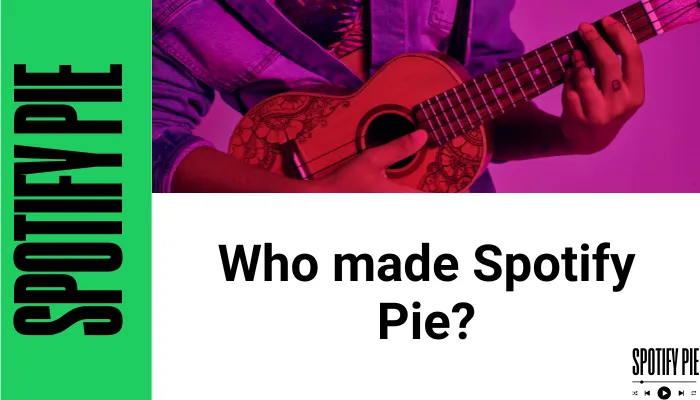The story of Spotify’s birth starts with a problem. So, “Who Made Spotify Pie?” A young Swedish tech entrepreneur called Daniel Ek was very frustrated by how dependent the music industry had become on illegal file-sharing websites like The Pirate Bay.
He thought about how people could have legal access to their favorite songs without any constraints thus prompting him to consider starting a streaming service. He joined forces with Martin Lorentzon, an experienced entrepreneur and they embarked on a mission to revolutionize music consumption.
The early days were not without hurdles. Getting major record labels to buy into a new model was difficult. For years Ek and Lorentzon negotiated licensing agreements that ensured fair recompense for artists as well as rights holders while offering users an interesting freemium offer.

The Recipe for Success is More Than Just Streaming
What made Spotify truly different was its innovative strategy. Here are some key things that drove its success:
| Key Features | Description |
|---|---|
| Freemium Model | In addition to the ad-supported free tier, Spotify offers a premium subscription with an ad-free listening experience, higher audio quality, and on-demand playbacks to appeal to different listeners. |
| User-Centric Design | Spotify’s intuitive interface and seamless user experience allow users to easily discover new songs through customized playlists, personalized recommendations, and a powerful search engine. |
| Global Expansion | Spotify strategically expanded into different markets, adjusting its offerings to suit local preferences and languages, solidifying its position as the topmost music streaming service. |
| Strategic Partnerships | Collaboration has been key to Spotify’s success, with partnerships with device manufacturers, social media platforms, and fitness trackers integrating Spotify seamlessly into people’s lives. |
Unveiling the Wrapped Phenomenon
Every December, music enthusiasts eagerly await Spotify Wrapped; this feature provides a personalized year-in-review that highlights one’s favorite artists, songs, genres, and other unique listening habits. But Wrapped is much more than just a metric of personal vanity.
- Wrapped’s Evolution: Wrapped has evolved from being a simple stat on your listening tastes back in 2016 to becoming some sort of cultural phenomenon today. It started with basic listening stats now it provides a visually appealing story format and shareable social media cards or even personal insights like “what kind of listener you are”.
- Behind the Magic: For Wrapped to be possible, Spotify relies on data collection and processing power. The platform tracks what you listen to over time analyzing such things as song choices play counts or even when exactly you listen to them during the day. All this information then gets transformed into a visually appealing narrative that is both familiar and personal.
- Engagement and Loyalty: Wrapped has become the tool to get users involved and make them loyal. This creates a sense of belonging when friends share their stories of Wrapped and even compare their list formation. Thus, yearly, it’s through this that Spotify continues to strengthen its bond with end users.
The story behind Spotify and Wrapped is proof that innovation matters alongside finding out what consumers want.
Artist Relationships, Playlists, and Indie Empowerment
Artist Relationships and Support, Unlike traditional music distribution that was prohibitive; Spotify builds strong relationships with artists. They provide different tools as well as resources that facilitate fan connection with artists, audience growth as well as important insights about how they are consuming their songs.
Curated Playlists and Discovery Features, No longer are people flipping through endless radio channels; personalized playlists like “Release Radar” or “Discover Weekly” from Spotify can help listeners discover new music that will be loved by them.
The Democratization of Music Distribution, In the past independent musicians faced very high barriers to entry. But by offering everyone access to its platform where they can upload their own songs directly bypassing traditional gatekeepers like labels etc., Spotify ensures that the process becomes completely open.
Key Stats:
- Over 8 million artists on Spotify
- 2 billion monthly active users
- Over 82 million songs in the library (as of April 2nd, 2024)
These figures show what a massive effect Spotify has had and how it has enabled music to be democratized.
Challenges and Criticisms
Spotify, however successful, also faces its own set of challenges:
- Royalty Disputes and Artist Compensation: One of the major criticisms leveled against streaming services such as Spotify is their low payout for every stream mainly to artists who have fewer followers. The compensation issue for artists in the age of streaming continues to be debated.
- Competition in the Streaming Industry: Music streaming is an extremely competitive field with Apple Music, Amazon Music, and YouTube Music all competing for market share. Spotify must keep on innovating so as to remain ahead of the curve.
- Regulatory Hurdles and Antitrust Concerns: As its dominance grows, there are concerns about antitrust as well as possible market manipulation by Spotify. Consequently, regulators are ensuring that fair competition as well as artist rights are upheld within this industry.
Speculations on the Future of Music Streaming and Spotify’s Role: Will virtual reality or augmented reality be part of how we listen to music? How will ownership models change? These changes are what will place Spotify with reference to the future of music.
Conclusion
In conclusion, “Who Made Spotify Pie?” Through this journey, it is evident that innovation has been at the forefront in responding to human needs for connection through songs. From its artist-first approach to its user-friendly systems as well as modern discovery tools, Spotify has revolutionized our access and experience with music.
However, despite all these challenges, even amidst all the difficulties ahead regarding music choices; Spotify remains committed to development alongside an audience in order for it to become one among several other big players who determine what happens next for the new generation of musicians.
This way; Spotify has continued to make itself relevant by making sure that it democratizes music while connecting musicians together globally hence keeping a never-static soundtrack from different parts of the globe unto which our lives have been built over time.
